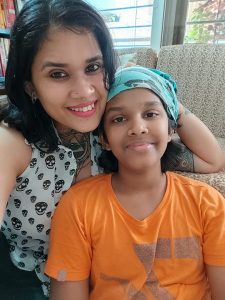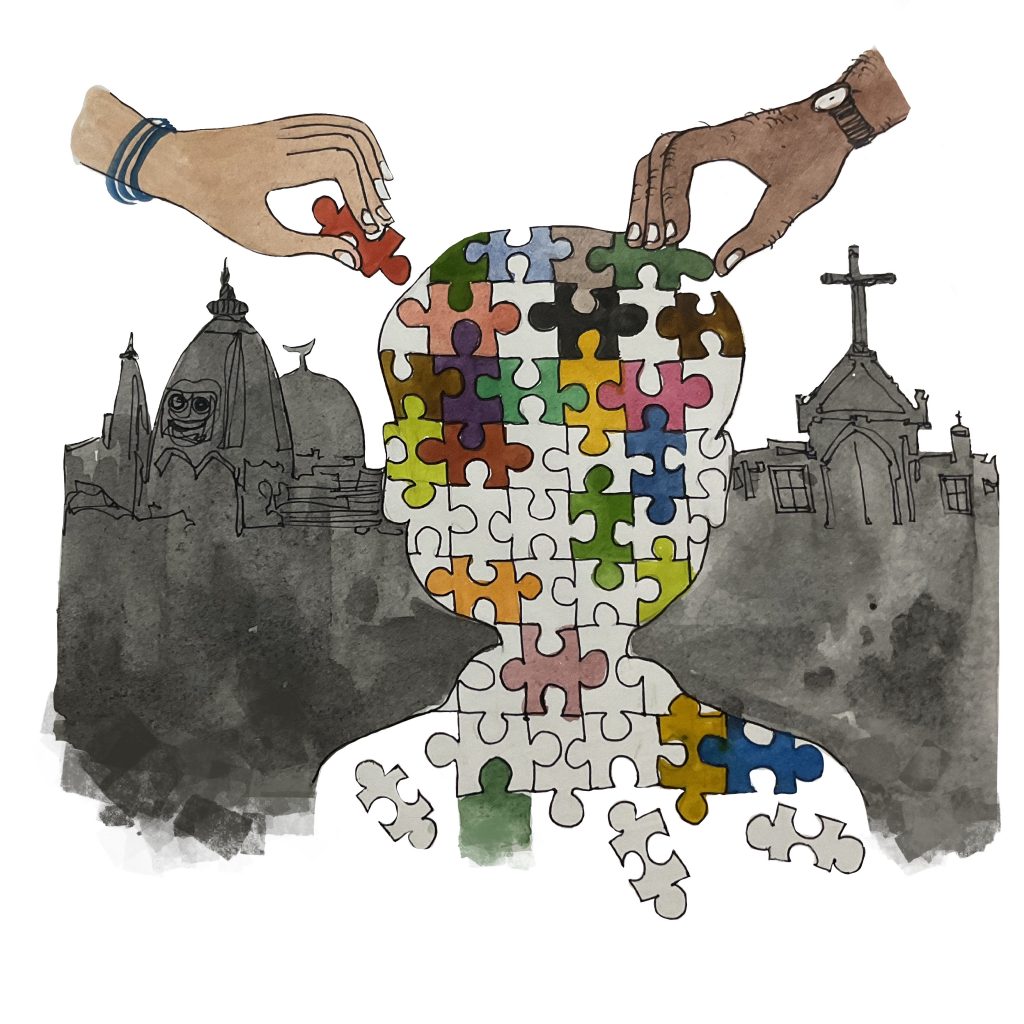The Churn Within
Recalling her personal experiences of being in an interfaith marriage and raising a mixed culture child helps URMI CHANDA confront some hitherto unacknowledged truths about herself and her life.
Introduction
Because this article is for a parenting magazine, and because I stand far out from what may be called normative lines, perhaps it is best started with a disclaimer. Or five. I am a divorcee. I am currently in a live-in relationship. I am a mother to a 13-year-old boy, who doesn’t live with me. My teenager is not getting any formal education because his father and I have decided to ‘unschool’ him. I have multiple tattoos and piercings, and have been through several career changes in the last decade. Not quite the ideal parent, yes? But there are a couple of reasons why I feel compelled to share my story…
One, I am currently working on my PhD in interfaith studies – a subject I am deeply interested and invested in, both as an academic and an activist. And two, for more than 10 years, I was in an interfaith marriage, which by most standards, was a decent one. In our time together, my ex-husband and I had a child, who we raised with love and freedom, trying our best to inculcate a sense of curiosity. We called it quits with a mutual and respectful divorce only when our life paths grew in different directions (my ex went from being a software professional to a woodworker, and I from a journalist to a full-time student). Our interfaith marriage was, in many ways, an epitome of our unconventional life choices, and it is from there that we found creative solutions to some of our uncommon problems.
Protagonists in the plot
My ex-husband is a Roman Catholic with a Goan and Mangalorean upbringing. The Catholics of Goa and the Catholics of Mangalore are often considered like chalk and cheese, although I never did see the effervescence of such an unlikely mix in their home nor in my ex’s behaviours. In fact, my ex is so unchristian in his living, that it would be hard for anyone to peg that identity on him. That he had a very Hindu name made it that much harder. He stopped going to church in his teenage years because he could no longer relate to certain Biblical diktats. His parents, though devout Catholics, never imposed anything on their four children.
I come from a Hindu background with my roots in West Bengal, although I’ve lived all my life in Maharashtra and consider this state my karma bhoomi. The only child of my parents, I was raised with a reasonable open-mindedness that is often associated with Bengalis. Of course, the casual Islamophobic caveat of “marry anyone but a Muslim” applied to me too.
I met my ex online, became great friends with him, and we were just taking our first tentative steps into dating, when the whole thing snowballed into a marriage! I was only 24, not ready, and thought his Christian background would be a deterrent to any such prospects, but my parents surprisingly and readily agreed to the match. I suppose my folks were happy enough with the ‘not a Muslim’ bit. My wedding happened with as little resistance as my divorce 12 years later. So, the last disclaimer to add here is that I’ve had it easier than most. I say this because in today’s sociocultural and political milieu, interfaith marriages invoke some rather intolerant and distressing reactions. Try falling in love with and marrying a person from another faith, and you might just be charged for love jihad or forced conversion and land up in jail.
Super-duper legitimate
My interfaith shaadi was a cakewalk compared to the challenges young people these days have to face, but that’s not to say it was without its share of problems. I remember feeling my insides squirm for the first time when I learnt about a certain non-negotiable norm of the Catholic church: that if a non-Christian is to marry a Christian in church, they must agree to raise their children in the Christian faith. I remember the squirming intensifying when I learnt that my mother-in-law (to be), too had one non-negotiable need, much like the Church she followed: that we get married in Church. I ignored my insides and let my rational brain and my liberal Hindu upbringing take over. I told myself that by default a kid takes on his father’s surname and faith anyway, so why confuse the kid by enforcing another faith on him? I reasoned that if I dug my heels and refused the Christian wedding and hence the Christian upbringing, my future Hindu kid would feel like a misfit in his father’s side of the family. Besides, I told myself that I could always teach him/ her the best of Hinduism and it would be okay. At 24, it is hard to imagine what one might feel about one’s could/ would-be child in the distant future, so I let it slide.
Another non-negotiable, if a tad more palatable, clause of the Church was a compulsory pre-marital counselling course that all betrothed couples had to undergo. My Hindu sensibilities were quite jarred with all the open talk about contraceptive planning, among other things, but I managed to maintain my cool façade and went through it. In retrospect, I realised the worth of the course and wished that all people, irrespective of their religious identity, would have the opportunity to go through such counselling. So many of us get so sucked into the glamour of Indian weddings that we lose sight of the hard work that follows. I was fortunate to have some of both –perspective and pomp. We got married three ways: the legal way, the Hindu way, and the Christian way, with a reception also thrown into the mix. In the case of an interfaith wedding, the need to seek legitimacy somehow seems thrice as important.
Enter the ‘issue’
The first year and a half of our married life passed for us in marital bliss, as it does with most others. We were both comfortably agnostic, and spent little or no time on the religio-cultural traditions we had respectively grown up with. I took to eating sorpotel (a celebratory spicy Goan dish made of pork) as easily as he took to eating maach-bhaat (fish curry and rice, a staple for Bengalis). We had no altars for worship at home, nor a television set. We had plenty of books and puzzles, and we were happy to be building this new ‘faithless’ life together.
The child to-be, however, was to appear much sooner in my life’s timeline than I had imagined. My son was born in the second year of my marriage, and being the first and only child of his generation, quickly became the center of everyone’s attention. I picked a Sanskrit name for him and it felt like a little bit of a vindication for having grudgingly conceded to that rule of the Church. At least he would bear his Hindu mother’s legacy in his first name, I consoled myself, even though deep inside, I continued to struggle with the idea of my child having a faith identity different from mine. To an onlooker, mine must have looked like a choice, but back then, I had neither the courage nor the heart to defy the mother of the man I loved. Besides, a point had to be proved about my liberal education. I could not say anything without feeling deeply ashamed of myself, so we sallied forth. But I was taken aback at how primal this preservation impulse was. I had to pit all my education and reason against it to tame it, but the niggling would not go away.
I saw clearly in that moment how resentments can build up, and how it can affect relationships in the long term. While the Christian church did not force me to convert for the wedding, they coerced me into signing up for what would essentially be a conversion of my progeny. Here lay one lesson for myself and for anyone who will have it: Love may grow stronger or wear off, but without true freedom of choice, a person will never be truly satisfied with their lot. For anyone considering an interfaith marriage, these tough discussions must take place much before any promises or provisions of marriage are made. A long, hard look at oneself, one’s values, a reckoning of what one holds to be truly important must be made before one takes the marital plunge.
I went back to work when my son was just six months old, and my most amiable mother-in-law took on her grandparenting duties most cheerfully. My in-laws were so wonderfully supportive that I never had to worry a day about my infant’s well-being and months turned to years. The ‘Christianity’ pressures were neither immediate nor constant, but they came alright. First came the ask for my son’s baptism. Since they hadn’t asked to baptise him soon after his birth, as is the norm with most Christian families, I had begun to secretly hope that they would forget. But around the time he was four, a Baptism was quickly done and there was little I could say or do about it. A few years later, came the ask for the first Communion, and again, I had no choice but the comply. It is said that during the third important life cycle ritual of Confirmation, a young person is asked if they truly want to come into the Christian fold, that is, confirm their faith. It is said to be a ritual of choice. But defections are exceedingly rare, and I know that when it is time for my son to make his Confirmation, he will do so without really thinking about it.
Bringing up J
As a devout student of culture, I should know, because this isn’t just about a person picking a faith. It is a person picking a whole culture, the basis for their identities, their whole selves. To those who argue that a person could be baptised into one religion but may have different spiritual and cultural practices, I almost entirely disagree. While religion, spirituality and culture are different academic categories, for all practical purposes, they are the same. Especially in a country like India, their convergences and overlaps are so many, that any attempt at separation is futile. Like Hinduism and other Indic faiths, the Indian versions of Islam and Christianity have also mutated into ‘ways of living’ rather than being just ‘religions’ as understood in the Western academia. Religion is not taught only through scripture or ritual. Religion is taught though language, literature, cuisine, and art as well. Religious and mythical motifs permeate all these branches of culture, and when we engage with them and reiterate the importance of what we hold sacred, we teach religion to our children.
As my son began to grow, speaking and understanding only English, my insides began to squirm again. I began to feel the pangs of a loss of my linguistic heritage. I could speak Bengali well, but as a probashi (non-resident of Bengal) kid, I had not learnt to read or write it well. And now with J, it looked like even the speech would be lost, and I would be responsible. But between my need to teach him his rightful “mother-tongue”, and the demands of my career, the latter won.
I wasn’t about to let up so easily, though. I resolved to pass on my HinduBengaliness to J in other ways. I ensured that like the Christian festivals of Christmas and Easter, Durga Puja and Diwali were celebrated with equal fervour. Even though he didn’t always understand or enjoy it, I made the effort to play Hindi and Bengali music and films around him, and took every opportunity to explain the religious and cultural references made in them. Then I turned to what I knew best – books. I tried to gently nudge him towards some Bengali children’s stories I had heard as a child, or even Amar Chitra Kathas in English, when the Bengali ones failed. But the kid would always – and predictably enough – lean into the shinier, Western choices. I wasn’t really hoping to compete and win against the Disneys and Pixars of the world, but one tries.
Where I feel I succeeded to a certain extent was making use of my training as a mythologist. Whenever there was scope, I told him stories from the Indian mythological universe that were comparable to his animated heroes. Knowing about Joseph’s Campbell’s ‘Hero’s journey’ had served me well. It helped me point out to him how for a Zeus, we had an Indian counterpart in Indra, or for a Poseidon, we had a Varuna of our own. I was able to tell him how, just like Elsa in the film, ‘Frozen’, Rama had to go into an exile to finally emerge victorious. Through these comparative tales, I was able to drive home the point of the underlying similarity of all human experiences and emotions, and consequently justify why everyone was equally deserving of love and respect.
Be and let be
My ex-husband and I separated around the time our son was 10-years-old, and he has been living with his father and his grandparents since then. He is still a child, and his upbringing now is almost entirely Christian, but it is an idea I have made peace with. In studying comparative mythology and religion and teaching some of it to J, the idea of humankind’s fundamental oneness made a deep impact on me. Today, my work is dedicated to that ideal and I spend my days trying to create a more equitable and peaceful world.
J and I visit each other often, and we talk about my work and the video games he plays and the Youtube stars he follows. The language of these conversations is neither Hindu nor Christian, neither Bangla nor English. It is a language of understanding what is important to the other, and offering them one’s full and undivided attention. It is perhaps something my ex-husband and I did not do enough, but something we are learning to do as unschooling parents.
In giving our son the choice to learn what he wants to learn, the pace at which he wants to learn, or not learn anything at all if he so chooses, we have learnt something valuable – that the key to making a marriage succeed, or being a successful parent – interfaith or otherwise – is to make space for one to manifest their truest self. Without that freedom, there is no joy, without joy, there is no love, and without love, life has not much meaning.
Urmi Chanda | urmi.chanda@gmail.com
 Urmi Chanda is a Harmony Scholar at the University of Wales Trinity Saint David, a culture journalist, and a peacebuilder in the making. When she is not researching, writing, or managing programs for non-profit organizations, she can be found moonlighting as a voiceover artiste. She is based in Mumbai, India..
Urmi Chanda is a Harmony Scholar at the University of Wales Trinity Saint David, a culture journalist, and a peacebuilder in the making. When she is not researching, writing, or managing programs for non-profit organizations, she can be found moonlighting as a voiceover artiste. She is based in Mumbai, India..

